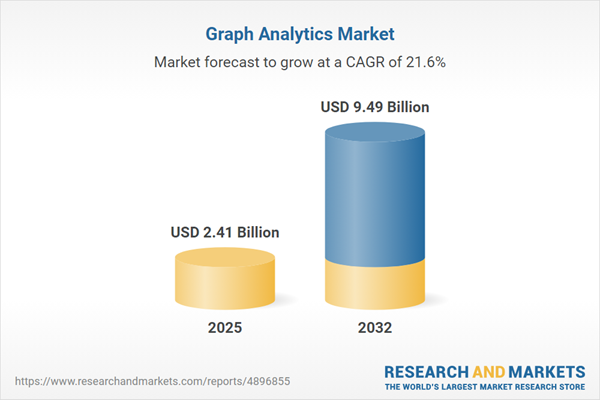Speak directly to the analyst to clarify any post sales queries you may have.
Graph analytics is fundamentally reshaping how large enterprises and mid-sized organizations drive operational effectiveness and gain actionable insights from complex, interconnected data environments. Senior decision-makers increasingly rely on advanced analytics to inform strategy and respond agilely to evolving regulatory, technological, and competitive developments.
Market Snapshot: Graph Analytics Market Size and Growth
The Graph Analytics Market grew from USD 1.99 billion in 2024 to USD 2.41 billion in 2025. It is expected to continue growing at a CAGR of 21.56%, reaching USD 9.49 billion by 2032.
Scope & Segmentation of the Graph Analytics Market
This market research provides a comprehensive review of the products, solutions, and services driving adoption in the graph analytics industry. The study delivers an in-depth breakdown of core segments and their relevance for organizations evaluating new technology investments:
- Component: Managed Services, Professional Services, Platform Software, Solution Software
- Organization Size: Large Enterprises, Small and Medium Enterprises
- Deployment Model: Private Cloud, Public Cloud, On Premises
- Application: Customer Analytics, Fraud Detection, Network Performance Management, Risk Management
- Industry Vertical: Banking, Financial Services and Insurance; Government; Healthcare; Information Technology and Telecom; Retail
- Region: Americas (United States, Canada, Mexico, Brazil, Argentina, Chile, Colombia, Peru); Europe, Middle East & Africa (United Kingdom, Germany, France, Russia, Italy, Spain, Netherlands, Sweden, Poland, Switzerland, United Arab Emirates, Saudi Arabia, Qatar, Turkey, Israel, South Africa, Nigeria, Egypt, Kenya); Asia-Pacific (China, India, Japan, Australia, South Korea, Indonesia, Thailand, Malaysia, Singapore, Taiwan)
- Key Companies: Amazon Web Services, Inc., Microsoft Corporation, Oracle Corporation, International Business Machines Corporation, SAP SE, Google LLC, Neo4j, Inc., TigerGraph, Inc., DataStax, Inc., ArangoDB GmbH
Key Takeaways for Decision-Makers
- Graph analytics enables rapid pattern recognition and real-time insights, empowering organizations to make more informed, connected decisions across supply chains, networks, and customer touchpoints.
- Integration with machine learning and artificial intelligence tools is enhancing predictive maintenance, fraud detection, and knowledge discovery, supporting better outcomes in highly regulated and data-rich industries.
- Low-code development tools and intuitive visualization platforms are broadening market access, allowing both technical and business teams to collaborate and drive analytics-enabled innovation.
- Enterprises benefit from deploying flexible hybrid and cloud deployment models that align with varying data residency, security, and performance needs across regions.
- Localized partnerships and joint development programs help optimize software-hardware interoperability, particularly as market dynamics and regulatory considerations evolve globally.
Tariff Impact and Strategic Shifts
Recent tariff policies introduced in the United States are reshaping procurement and deployment patterns for graph analytics solutions. Higher duties on imported hardware are leading enterprises to allocate budgets toward software and cloud-centric offerings. This adjustment encourages collaboration among local system integrators and global providers, fostering robust supply chain continuity and resilience for regulated sectors. Financing incentives and shifts in licensing support models are helping offset cost increases associated with hardware sourcing.
Methodology & Data Sources
This report utilizes both primary and secondary research. Market trends and segmentations are drawn from industry publications, financial disclosures, and proprietary databases. Insights and qualitative context have been enriched via executive interviews, surveys, and expert consultations to validate adoption factors, solution preferences, and regional nuances.
Why This Report Matters
- Provides senior executives with a strategic, actionable overview of technology, regulatory, and business developments impacting graph analytics investments.
- Equips decision-makers with detailed segmentation and regional analysis to align technology strategies with regulatory realities and growth opportunities.
- Delivers supplier intelligence and operational best practices necessary for optimizing deployment and monetizing analytics investments, tailored for the evolving demands of modern enterprises.
Conclusion
This market research provides senior decision-makers with a clear framework for navigating the evolving landscape of graph analytics. Informed investment strategies and strong ecosystem partnerships can help enterprises drive operational excellence and sharpen their competitive edge.
Additional Product Information:
- Purchase of this report includes 1 year online access with quarterly updates.
- This report can be updated on request. Please contact our Customer Experience team using the Ask a Question widget on our website.
Table of Contents
3. Executive Summary
4. Market Overview
7. Cumulative Impact of Artificial Intelligence 2025
Companies Mentioned
The companies profiled in this Graph Analytics market report include:- Amazon Web Services, Inc.
- Microsoft Corporation
- Oracle Corporation
- International Business Machines Corporation
- SAP SE
- Google LLC
- Neo4j, Inc.
- TigerGraph, Inc.
- DataStax, Inc.
- ArangoDB GmbH
Table Information
| Report Attribute | Details |
|---|---|
| No. of Pages | 183 |
| Published | November 2025 |
| Forecast Period | 2025 - 2032 |
| Estimated Market Value ( USD | $ 2.41 Billion |
| Forecasted Market Value ( USD | $ 9.49 Billion |
| Compound Annual Growth Rate | 21.5% |
| Regions Covered | Global |
| No. of Companies Mentioned | 11 |









